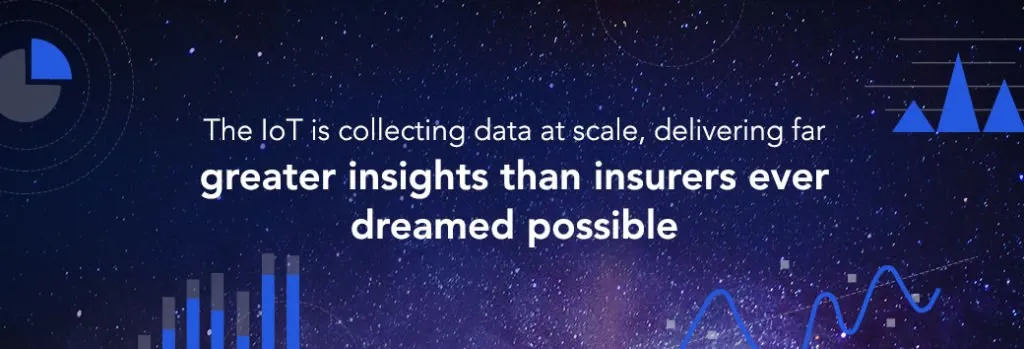

The Internet of Things (IoT) is transforming the insurance space. Though IoT is still in its relative infancy, and though the insurance industry is traditionally very slow to change, many insurers are already jumping on board. In 2016, McKinsey wrote in their report, Insurers need to plug into the Internet of Things — or risk falling behind:
“… the insurance industry – a sector that is traditionally slow to adopt new digital approaches but has still managed to prevail – may feel instinctively tempted to maintain this pace rather than take bolder, more urgent action on IoT.
“Nevertheless, accelerating their approach to IoT is exactly what insurers should consider given the speed and scope of the shift that has already taken place and can be expected to continue. An example of the fast pace of change is the connected-car ecosystem, arguably the most mature of the emerging and insurance-relevant new ecosystems.”
As the IoT ecosystem continues to grow and technology advances, the opportunity for insurers will only expand. In the current environment, insurers are already leveraging IoT technology to better predict and evaluate risk, expedite claims processing, improve sales and marketing strategies, better price products, gain a 360-degree view of their customers across product lines, and so much more. Essentially, the IoT is collecting data at scale, delivering far greater insights than insurers ever dreamed possible.

Sound exciting?! It is, especially for the insurance space — an industry whose entire business model is based on data and forecasting.
If you are an insurer eager to get started with IoT, you may be wondering where to begin. Or you may be overwhelmed by the thought of collecting so much new data. After all, what will you do with it all and how will you analyze it to create meaningful insight?
These are common — and valid — concerns. In this article, we will provide advice on how to get started with IoT and offer ideas on how to best leverage the data you collect. But first, let’s acknowledge where you are today: You’re interested in learning more about IoT for your insurance business. And that is a great place to start! You’re on the right track. Now let’s discuss what you should consider next.
Getting Started with IoT in Six Steps

Step 1: Tread lightly
When getting started with IoT, you’ll want to take your time. As excited as you might be about leveraging all this newly collected customer and geographical data, this isn’t something you want to rush into. After all, it will take time to collect enough data to realize meaningful trends. Which also brings up a somewhat contrary point: You shouldn’t put off implementing IoT — because the longer you wait the more data you miss out on. It’s one of those “hurry up and wait” situations. But once the data starts accumulating and you start to see real trends, you’ll quickly forget about the brief waiting period — and you’ll be happy you took your time to set up processes and software correctly from the start.
Step 2: Pick a venue, build a plan, create a proof of concept
Before you implement any type of IoT technology, you should run a test by building a proof of concept using a pilot program. The first step in this test process is choosing a venue and creating a plan. There are thousands of places where you can implement IoT sensors to collect data and improve your operations, but for now just focus on one medium – preferably something that has been well-tested by other insurers already, such as wearables or vehicles.
Step 3: Create your policy
Data privacy is an important component that must be kept in mind when leveraging IoT. To collect personal or behavioral customer data, you’ll need customer consent, which means you’ll likely have to give a good reason for them to provide that consent. Customers are unlikely to give you the go-ahead to monitor their driving patterns, for instance, without a receiving a benefit in return, say a reduction in insurance premium for good driving. Consider creating a plan that lets users tailor their policy to their specific needs and wants. When creating your policy, do so thoughtfully, with the customer and your business in mind — you want to collect a large data set without sacrificing profitability.
Step 4: Engage your organization
The members of your organization are the keepers of years of accumulated insight. Unlike with IoT technology, this insight is trapped in the head of each employee, not aggregated and not easily accessible. Their insight is critical to creating a use case to test your IoT proof of concept. Talk to each department, such as claims and underwriting to learn more about your policyholders. Employees in your organization may provide you with valuable insights into your customer data. Using this information can assist you in distinguishing which risks you are willing to accept and which ones you are not. Smart insurers use data to both up-sell and down-sell products.
Step 5: Don’t forget about security
As an insurer, you are already privy to a great deal of sensitive customer information. When creating a proof of concept using IoT strategies, it is critically important to ensure that personal identifiable information (PII) is stored and secured so that nothing is left exposed to third parties. By keeping accounts anonymous, with no actual personal or geographical information attached, you can help protect your customer while still gaining valuable insight.
Step 6: Evaluate your existing technology
Many insurance companies today are still running on legacy mainframe computers. This aging technology was not built to handle today’s vast amounts of information or report on the desired level of granularity. So, before you get too far down the road with an IoT solution, make sure you have the infrastructure to support it. And, if you don’t, evaluate your current systems with an eye toward what needs to be updated first in order to support the healthy functioning of an IoT solution.
Running with Your Newly Collected Data
Once you have data, the possibilities are nearly endless. For instance, if you sell car insurance you may be able to install sensors into your insured vehicles. With these sensors you’ll be able to monitor hundreds of user behaviors, from braking patterns to how many miles someone drives in a year. This information could help you price policies specific to individual users or demographic groups. For instance, by analyzing trends over time you may find that while boys under 21 were thought to be the most reckless on the road, the data actually shows that it is girls under 21 that are the greatest risk. With this data-backed insight you can adjust your premiums accordingly. Similarly, IoT can assist with post-accident analysis by providing information on speed, events prior to the accident, weather conditions and more.
In healthcare, wearables provide the perfect conduit for IoT sensors, helping insurers monitor everything from activity level to vital health signs, and then helping them price policies accordingly. Property and casualty insurers are using the IoT to feed geographic information system (GIS) technology in order to leverage geophysical, topographical, climatological and hydrological data that provides real-time information from which insurers can create startlingly accurate predictions.
Microsoft Azure IoT Suite
To help insurers like you get started with IoT, the Azure platform offers a robust solution from which you can add sensors and smart devices; control, monitor and manage your devices; analyze your data; and act on insights to create new revenue streams and business opportunities. With Azure, you can react to data fast and update business processes and offerings accordingly, so that your revenue keeps growing while your risk keeps declining.

Thanks to the IoT, the insurance industry is undergoing a massive shift, as insurers learn to adapt and grow in a digitized marketplace. As CIO wrote, “Gone are the days of the insurance policy that is only given thought twice in its life: at point of purchase and point of claim. Thanks to emerging technologies like the IoT, the insurance industry is experiencing a digital transformation that allows insurers to turn traditional peace of mind into more frequent value-add touchpoints with policyholders.”

Are you ready to see what IoT can do for your insurance business? Contact us at Hitachi Solutions to learn more about getting started with IoT.


